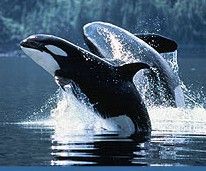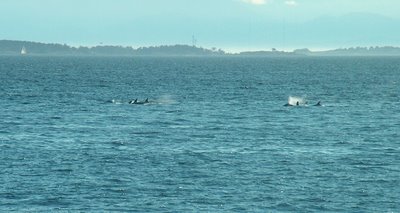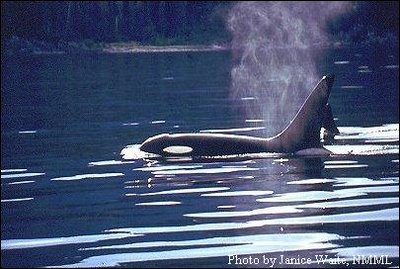
Orcas; photo from www.estuaries.org
Lime Kiln State Park is the center of a lot of Orca research. The windows of the park's small lighthouse are filled with graphs and data from doctoral research projects, posted there for whale-viewers to peruse while they wait for whales. A small crowd of 2 to 15 people gathers near the lighthouse every summer afternoon, waiting for the killer whales to come tooling down the Strait of Juan de Fuca, which is 8 miles wide at that point. The Orcas are eating salmon as they travel through. Researchers have identified 3 pods or family groups of Orcas that live in the strait - the J, K, and L pods. The members of a pod stay together most of the time. A pod is matriarchal - all are descendents of a single female who leads the group. J and K pods have 20 something members each; L pod has more than 40. The matriarch of each whale pod is several decades old, and great-grandma to some of the youngest whales.
The afternoon of August 2 we were hanging out at Lime Kiln State Park by the lighthouse, waiting. We were hoping the whales would come soon, we were hungry and tired. The only other people there were a pair of earnest-looking women perched on the rocky outcropping overlooking the water, discussing Orca sightings. One of them had what looked like an electric toothbrush - but it turned out to be a radio, a most useful tool in locating whales. She was listening in to the radio conversation among the whale-watching boats about the Orcas' whereabouts. I asked her what the scoop was, she told me the killer whales were headed our way. Sure enough, after about 5 minutes we could see the small clot of boats that generally follow the whales - three or four small whale-watching boats with clients, and one or two private boats. We could see the boats long before we could see any whales. The first we saw of the whales themselves was just the splashing water as they breached, or leapt from the water and slapped back down on the surface, something they apparently do just for fun.
After a few more minutes, we could see more than splashing - we could see the beautiful black and white bodies of the killer whales, swimming and apparently playing.
Killer whales are the top of the food chain. No animals can kill adult Orcas, not even Great White Sharks. Orcas can kill almost anything they want to kill - other whales and sharks included. Although the resident J, K, and L pods eat mostly salmon, the "transient" Orcas that just move through the San Juan Island area on the way to somewhere else feed heavily on marine mammals. They can toss a seal in the air like popcorn, can snarf down sea lions that weigh a ton, literally. They don't eat humans though. We saw sea kayakers very near the whales - the whales never bother them. Why? Same with wolves. Wolves never attack humans, although they easily could. I don't know why.
We were told that, on some days at Lime Kiln State Park, the whales swim through the water right below the lighthouse, right through the sea kelp along the shore (which is deep right at the shore line). We weren't so lucky though. The whales we saw were much farther out. We could see and hear their spouts (exhaled breaths) though, at times. A spout started with a puffing sound, like air blown suddenly out of pursed lips. The subsequent whoosh had a resonance as of air coming from a deep and hollow chamber. Hard to describe. I guess the whales were 200 yards offshore.
The boats were keeping their distance pretty well - the guideline is at least 100 yards between whale and boat, to minimize disturbance to the whales. The sound of engines is thought to disrupt the whales' communication with each other. (Each pod has its own dialect!) Also, boat exhaust can be a health hazard when the Orcas come up to breathe. Not to mention just the harrassment factor of being trailed every day by a flotilla of boats. But....on the bright side....one of the graphs posted in the lighthouse showed that during the 1970s, an average of 26 boats followed each pod as it moved past Lime Kiln State Park on any given day. Now the average number of boats following a single pod of whales moving down the strait is 8. That's still a lot. But better than 26. The two days I watched though, I didn't see as many as 8 boats around any single group of whales. It was more like 4 or 5. Sometimes only a couple of boats. But maybe that's because the Orca-watching season begins to wane in August. As we watched, the whales stopped moving from time to time, playing and breaching. Then the pod would take off again, moving on down the Juan de Fuca Strait, seeking salmon.
Salmon populations are declining in the area, overfished like everything else. (See www.wildsalmoncenter.org for info on salmon conservation efforts.) But the population of resident Orcas in Juan de Fuca Strait (pods J, K, and L) is holding steady nonetheless at present, numbering in the low 90s. A few decades ago, they were target practice for salmon fishermen. That "sport" has ended.
Most of the time we were watching the whales, all we could see were the fins sticking up. As the Orcas swim, they undulate up and down in an S-shaped path, so that a part of the back rises out of the water at the high points of the undulations. The whales breathe when the back is up, as in the picture below. The visible spout or cloud that results from their breathing is the warm vapor in their breath condensing into droplets in the cooler air. They even swim while they're sleeping - only half the brain sleeps at any given time.
The resident population of Orcas in Juan de Fuca Strait was listed as endangered last year, even though their numbers are steady. They're threatened by water pollution, salmon decline, and boat traffic. In July of 2006, federal officials proposed naming the U.S. half of the strait as critical habitat. You can read more about the critical habitat proposal at Seattlepi.com. To read more about Orca conservation in the San Juan Island area of Washington and Orca biology in general, check out the www.whalemuseum.org. For more about Orca conservation issues in the north Pacific and Alaska area, see the National Marine Mammal Laboratory web site.
Orcas are pretty cool, and very predictable as whales go. I really enjoyed meeting the community of whale fanatics that hang out at Lime Kiln State Park every day, waiting for the whales to show - a group that ranged from kids carrying whale plush toys to research scientists. Wildlife watching used to be a solitary activity for me. But now, I realize that if we as conservationists are to make a difference for wildlife in the future, we have to involve communities of people. We have to develop sustainable ways for people to make a living from the ecosystems around them, such as ecotourism. We especially have to support local people who are trying to transition from "harvesting" of wild animals and plants to more sustainable ways of depending on their environment for their livelihoods. People who depend on the Orcas for their living are more likely to support limits on pollution and boat traffic, more likely to support salmon conservation measures.
If you like whales, if you're interested in seeing a community that is sustainably making a living from local wildlife and ecotourism, visit San Juan Island. And you want to see Orcas from shore, a great place to do it is Lime Kiln State Park.
Sally Kneidel, PhD
Co-author of Veggie Revolution














No comments:
Post a Comment